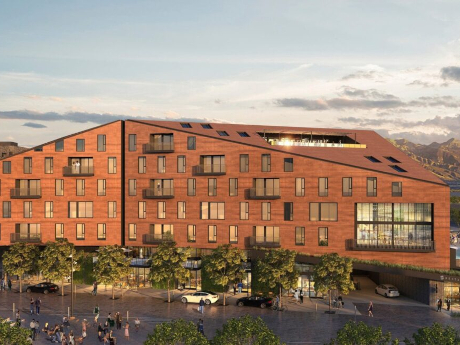— By Greg Swedelson and Jon-Eric Greene, co-founders, SSG Realty Partners —
Although there continues to be much speculation and concern about the impacts of inflation, high debt costs, rising unemployment and an economy that may be heading for a slowdown in the coming year, there is reason to believe that the outlook for the Salt Lake City commercial real estate market is quite positive.
With more than $100 billion in annual GDP, Salt Lake City’s economic growth rate is poised to end the year up nearly 3.5 percent (and nearly 80 percent since 2011). Although many are projecting a more moderate growth rate of 2.8 percent entering 2024, the overall economy and commercial real estate market in SLC remain resilient, if not robust. Offering a combination of affordability, abundant job opportunities and a business-friendly environment, SLC has attracted some of the nation’s largest corporations and specialized tech companies, and with them, talent to fuel meaningful employment growth. So much so, in fact, that net employment is up nearly 10 percent over the pre-Covid levels of 2019, with no sign of slowing.
Like so many markets, SLC has seen a precipitous drop in investment sales volume across all commercial sectors throughout 2023, with retail sales volume being particularly anemic. Asset pricing also continued its decline, with traditional banks and financial institutions essentially in lock down mode for most of the year and 1031 cash buyers becoming more rate sensitive, commercial cap rates jumped to a blended rate of 6.25 percent, with retail ascending to the highest average rate of 6.75 percent, more than 125 basis points higher than the prior year.
After a surge in new construction, particularly in the multifamily sector, construction starts are expected to slow in 2024. With so much multifamily product scheduled for delivery, we expect to a see a softening of the multifamily market in pricing. Similar impacts are being felt in the once-unstoppable industrial sector as well.
While sales volume and pricing have fallen over the past year, for those developers and investors operating commercial assets (other than downtown office, of course), the news is much more encouraging. SLC boasts strong growth in rents across all commercial classes. And while retail sales volume may have taken a significant hit, rental growth in the Salt Lake City market has been impressive and is likely to continue well into 2024. It was not long ago when retail rents in the SLC market were in the mid-teens and topped out in the $18 per square foot range. Currently, retail lease rates are averaging over $21 per square foot NNN (and non-anchored strip averaging over $22 per square foot NNN), a record increase of nearly 9 percent YOY. With positive net absorption of new product and existing inventory, the retail vacancy rate for the Salt Lake metropolitan area remains stubbornly low in the 3.5 percent range (compared to office vacancy of 22.5 percent), representing one of the lowest rates among all major U.S. metropolitan markets. And the retailers appear quite healthy and well positioned to absorb these increases, as retail sales growth across the city has grown over 8 percent this year, representing one of the highest metropolitan area sales growth rates reported.
Furthermore, much like many other burgeoning cities throughout the nation, Salt Lake City has invested substantially in revitalizing much of the urban core and surrounding neighborhoods (such as the Granary District, Post District and Sugar House). Some of these infrastructure projects include the planned 9 Line, a nearly three-mile project corridor running 18 city blocks just two miles south of downtown Salt Lake City. This East-West corridor along 900 South between 900 West and Lincoln Street contemplates various roadway improvements, such as landscaped medians, on-street parking, protected bicycle lanes, street trees and street furniture, to encourage greater pedestrian and bicycle activity and to maximize SLC’s already excellent mass transportation system. Other examples include the 300 West Corridor reconstruction (a major North-South thoroughfare) and Main Street in downtown, which is being reimagined as a full-width pedestrian and transit mall with no vehicular traffic.
A certain level of cautious optimism seems to pervade as we head into 2024. We recently assisted a developer client acquire a highly desirable property along the 9 Line corridor. The project has been taken through pre-development, including entitlement, design and permit application; however, developing under the current economic conditions doesn’t pencil, and the developer is likely to hold pat until the multifamily market stabilizes. Stabilization in this case means more of the existing inventory is absorbed (there are currently more than 9,000 units in construction and/or delivery phase countywide, with another 5,000 units proposed for future development); debt becomes more readily available by traditional sources at more attractive rates and terms; and inflation has subsided with respect to labor and materials costs. This developer is by no means alone as several other projects find themselves on hold, particularly in the multifamily sector, where past underwriting with cheap debt made development possible despite inflationary factors.
If there is one thing we can predict in this era of unpredictability, it is that 2024 should be interesting — another chapter in this unusual economic cycle.


